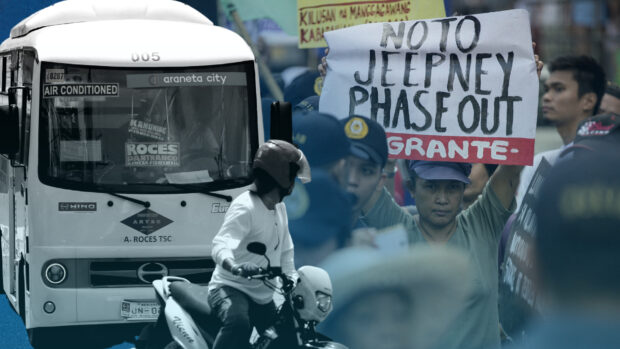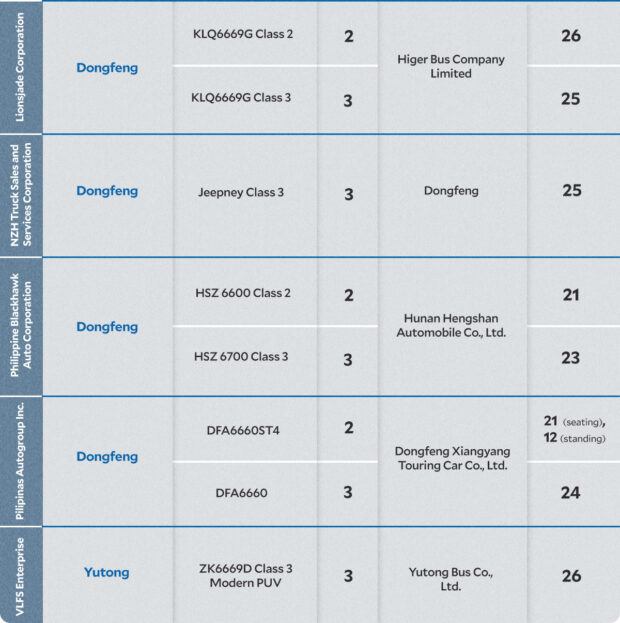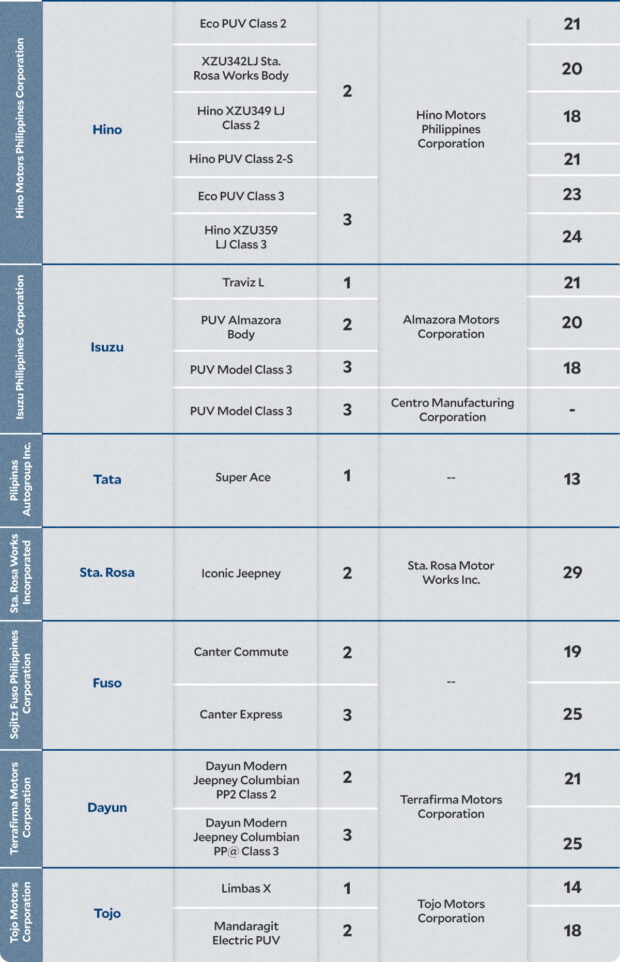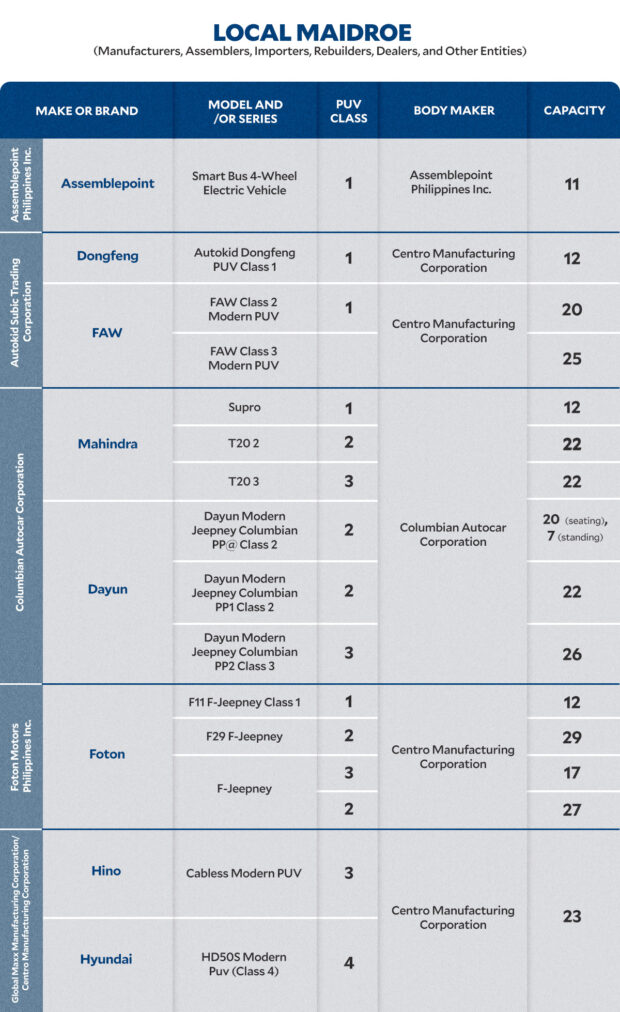PUV modernization: PH jeepneys out, China imports in

INQUIRER.NET COMPOSITE IMAGE (Photos from Agence France-Presse)
MANILA, Philippines — The deadline for public utility vehicle (PUV) consolidation has been extended and the government has already stressed that it will not be the one to decide on the brand of modern vehicles for the modernization program.
“Only the cooperatives can decide, not the government,” a government statement said in Filipino.
But even with the government stating that cooperatives would decide which brand to get — locally made, from Japan or China or any other country — its words were still not enough to erase fears about the modernization program, which, the government said, is its response to the Philippines’ problems on transportation.
Here’s why.
As pointed out by Sarao Motors Inc., local manufacturers can make modern vehicles that are compliant with the Philippine National Standard, the problem, however, is the uncertainty of the market: “If there is a demand for it, local manufacturers like us will certainly find a way.”
But in the absence of direct preference by the government for locally made modern vehicles, Leonard John Sarao, architect and operations supervisor of Sarao Motors Inc., said it would be impossible to ease people’s fears, especially about being left behind.

GRAPHIC: Ed Lustan
“Now, jeepney sales are really not good because of concerns about the impending modernization. [People] are hesitant to buy new units because of fear that the new units will end up prohibited eventually,” Sarao told INQUIRER.net, stressing the need for immediate government intervention.
He pointed out that “if the government proposes that you get a modern jeepney from a local manufacturer, and that manufacturer is accredited, I think it will be enough to ease the fear.”
Strong demand ‘needed’
Based on data from the Department of Transportation (DOTr) as of Jan. 29, there are already 54 modern PUV models considered compliant with the requirements set by the government for the modernization program.
Sarao explained that they currently have a prototype, however, it is only a “body and chassis unit” since “we haven’t installed the powertrain on it for the reason that it can be either [Euro] compliant engine or completely electric.”
But the problem, he said, is that as local manufacturers, “while we have already reached out to certain established brands that offer the said kind of engine, they are still hesitant to release a lot.”

GRAPHIC: Ed Lustan
This, as there are also concerns “whether the local market will have enough large demand to cater for them to import a lot of these engines,” Sarao said, pointing out the need for the government to advertise local manufacturers, too.
As the DOTr explained, there are three classes of PUVs in the government’s modernization program: Class 1, Class 2, and Class 3.
Class 1 PUVs, it said, are 9 to 12-seaters that are good for “narrow” barangay, municipal or provincial roads, while Class 2 and 3 are 23-seater PUVs that are considered as replacement to PUJs.

GRAPHIC: Ed Lustan
The DOTr said Class 2 has the regular PUJ seating, but with ceiling height that will let average Filipinos stand in the middle. Class 3, meanwhile, is a “front-facing variant,” which is the required replacement for all UV Express vehicles, or vans that ply as PUVs.
Not Filipino
Out of the 54 modern PUV models that were already given certificates of compliance, 34 are locally manufactured or assembled, while 20 are imported and “completely built-up,” or already assembled, according to DOTr data.
But while only 20 have been outrightly tagged as “imported,” most of the “make or brand” with certificates of compliance are not even Filipino.
Here’s a list of “make or brand” employed by “Manufacturers, Assemblers, Importers, Rebuilders, Dealers, and Other Entities (MAIDROE)” with certificate of compliance as of Jan. 29:
- Assemblepoint
- Dongfeng
- FAW
- Mahindra
- Dayun
- Foton
- Hino Hyundai
- Isuzu
- Tata
- Sta. Rosa
- Fuso
- Tojo
- Zhong Zhi
- Zhong Tong
- JMC, or Jiangling Motors Corporation
- Wuling
- JAC Angkai
- Kingling Isuzu
- Yutong
Based on DOTr data, the average cost of Class 1 PUVs is P1.30 million, while Class 2 and 3 PUVs are worth P2.48 million and P2.65 million.
However, as the Land Transportation Franchising and Regulatory Board had said, local and Japanese manufacturers have modern vehicles worth only P900,000 to P985,000, and with P280,000 assistance from the government, the cost is expected to even drop to less than P700,000.
Those from China, conversely, cost P1.8 million to 2.8 million.
‘Name contractors’
Last month, Senate Minority Leader Aquilino Pimentel III asked the DOTr to name the contractors who could rake in billions from supplying the modern PUVs that would soon replace the Philippines iconic passenger jeepneys.
As indicated in the 2024 General Appropriations Act, the DOTr set aside some P1.6 billion for the modernization program.
Pimentel pointed out that since the inception of the program in 2018, the government was determined to procure the “box-like” mini buses that are said to be manufactured by Chinese companies instead of looking for local suppliers.
He said that Sarao Motors, one of the pioneer jeepney makers in the Philippines, had previously offered to build environment-friendly vehicles that would cost less than the imported units, as in the program, modern PUVs are required to have at least Euro 4-compliant engines and other safety features such as handrails and security cameras.
Pimentel explained that as required by law, suppliers of the modern PUVs should meet the requirements for accredited government contractors, stressing that contracts should be awarded only to those that would be able to provide the best deal through a transparent public bidding.
“Since this is a government-mandated program, it is as if the government is the one procuring (the vehicles),” he said.
RELATED STORIES
Romualdez appeals for extension of PUV modernization program
PUV drivers, operators told to take advantage of consolidation deadline extension
Toyota commits P1.1 billion boost to PH’s PUV modernization
PUV modernization: Understanding defiance of operators, drivers
Disclaimer: The comments uploaded on this site do not necessarily represent or reflect the views of management and owner of Cebudailynews. We reserve the right to exclude comments that we deem to be inconsistent with our editorial standards.


